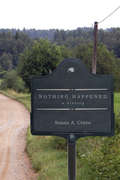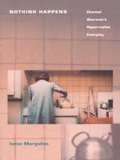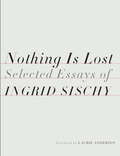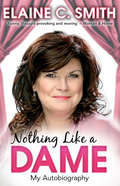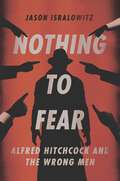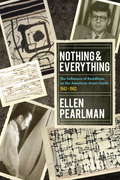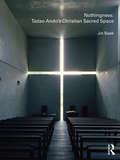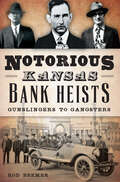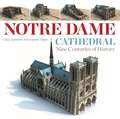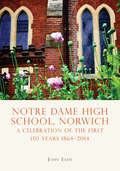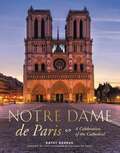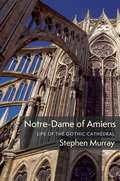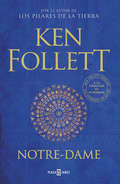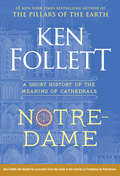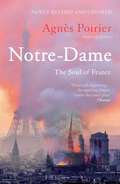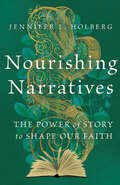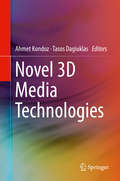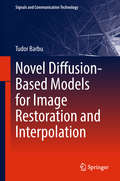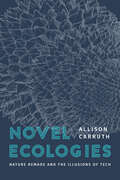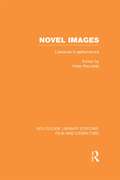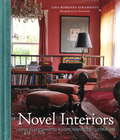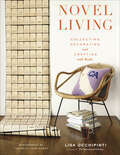- Table View
- List View
Nothing Happened: A History
by Susan A. CraneThe past is what happened. History is what we remember and write about that past, the narratives we craft to make sense out of our memories and their sources. But what does it mean to look at the past and to remember that "nothing happened"? Why might we feel as if "nothing is the way it was"? This book transforms these utterly ordinary observations and redefines "Nothing" as something we have known and can remember. "Nothing" has been a catch-all term for everything that is supposedly uninteresting or is just not there. It will take some—possibly considerable—mental adjustment before we can see Nothing as Susan A. Crane does here, with a capital "n." But Nothing has actually been happening all along. As Crane shows in her witty and provocative discussion, Nothing is nothing less than fascinating. When Nothing has changed but we think that it should have, we might call that injustice; when Nothing has happened over a long, slow period of time, we might call that boring. Justice and boredom have histories. So too does being relieved or disappointed when Nothing happens—for instance, when a forecasted end of the world does not occur, and millennial movements have to regroup. By paying attention to how we understand Nothing to be happening in the present, what it means to "know Nothing" or to "do Nothing," we can begin to ask how those experiences will be remembered. Susan A. Crane moves effortlessly between different modes of seeing Nothing, drawing on visual analysis and cultural studies to suggest a new way of thinking about history. By remembering how Nothing happened, or how Nothing is the way it was, or how Nothing has changed, we can recover histories that were there all along.
Nothing Happens: Chantal Akerman’s Hyperrealist Everyday
by Ivone MarguliesThrough films that alternate between containment, order, and symmetry on the one hand, and obsession, explosiveness, and a lack of control on the other, Chantal Akerman has gained a reputation as one of the most significant filmmakers working today. Her 1975 film Jeanne Dielman, 23 Quai du Commerce, 1080 Bruxelles is widely regarded as the most important feminist film of that decade. In Nothing Happens, Ivone Margulies presents the first comprehensive study of this influential avant-garde Belgian filmmaker.Margulies grounds her critical analysis in detailed discussions of Akerman's work--from Saute ma ville, a 13-minute black-and-white film made in 1968, through Jeanne Dielman and Je tu il elle to the present. Focusing on the real-time representation of a woman's everyday experience in Jeanne Dielman, Margulies brings the history of social and progressive realism and the filmmaker's work into perspective. Pursuing two different but related lines of inquiry, she investigates an interest in the everyday that stretches from postwar neorealist cinema to the feminist rewriting of women's history in the seventies. She then shows how Akerman's "corporeal cinema" is informed by both American experiments with performance and duration and the layerings present in works by European modernists Bresson, Rohmer, and Dreyer. This analysis revises the tired opposition between realism and modernism in the cinema, defines Akerman's minimal-hyperrealist aesthetics in contrast to Godard's anti-illusionism, and reveals the inadequacies of popular characterizations of Akerman's films as either simply modernist or feminist. An essential book for students of Chantal Akerman's work, Nothing Happens will also interest international film critics and scholars, filmmakers, art historians, and all readers concerned with feminist film theory.
Nothing Is Lost: Selected Essays
by Laurie Anderson Ingrid SischyFrom the late editor, writer, and critic, one of the great chroniclers of the art, fashion, and celebrity scenes: an expansive collection of thirty-five essays that offer an intimate look into the worlds of some of the most important and well-known artists, designers, and actors of our time.For more than three decades, Ingrid Sischy's profiles and critical essays have been admired for their keen observation and playful style. Many of the pieces that appeared in The New York Times Magazine, The New Yorker, and Vanity Fair from the 1980s to 2015 are gathered here for the first time, including her masterful profiles of Nicole Kidman, Kristen Stewart, Miuccia Prada, Calvin Klein, Jeff Koons, Jean Pigozzi, Alice Neel, and Francesco Clemente, among others, as well as her exclusive interview with John Galliano after his career nose-dived in 2011. Whether writing about a young Alexander McQueen, the photography of Robert Mapplethorpe, Sebastião Salgado, Cindy Sherman, or Bob Richardson, or the Japanese musical theater group Takarazuka Revue, Sischy's close attention to the unexpectedly telling detail results in vividly crafted, incisive portraits of individuals and their works. Here is a unique collection that gives readers unprecedented access to a dazzling range of artists from one of the greatest cultural critics of a generation.
Nothing Like a Dame: My Autobiography
by Elaine C Smith'How did I end up here?' A question Elaine C. Smith asked herself when sitting in the dressing-room of a top theatre in London's West End, about to go on stage with one of the UK's most successful plays.In Nothing Like a Dame, Elaine reflects on a 50-year journey that took her to the peak of the entertainment world. She recounts her long struggle to make it in a male-dominated, working-class society when women were supposed to just shut up and stay thin, especially in the sexist world of theatre and television, where she was told, 'Look, women just aren't funny.'Despite many highs and lows, she proceeded to forge a stellar career in show business, hosting her own TV series and becoming a household name thanks to her comic portrayal of Mary Nesbitt, the long-suffering wife in the award-winning BBC comedy Rab C. Nesbitt.Nothing Like a Dame is a heart-warming memoir: candid, outspoken, hilarious and at times deeply sad.
Nothing Permanent: Modern Architecture in California
by Todd CronanA critical look at the competing motivations behind one of modern architecture&’s most widely known and misunderstood movements Although &“mid-century modern&” has evolved into a highly popular and ubiquitous architectural style, this term obscures the varied perspectives and approaches of its original practitioners. In Nothing Permanent, Todd Cronan displaces generalizations with a nuanced intellectual history of architectural innovation in California between 1920 and 1970, uncovering the conflicting intentions that would go on to reshape the future of American domestic life.Focusing on four primary figures—R. M. Schindler, Richard Neutra, and Charles and Ray Eames—Nothing Permanent demonstrates how this prolific era of modern architecture in California, rather than constituting a homogenous movement, was propelled by disparate approaches and aims. Exemplified by the twin pillars of Schindler and Neutra and their respective ideological factions, these two groups of architects represent opposing poles of architectural intentionality, embodying divergent views about the dynamic between interior and exterior, the idea of permanence, and the extent to which architects could exercise control over the inhabitants of their structures.Looking past California modernism&’s surface-level idealization in present-day style guides, home decor publications, films, and television shows, Nothing Permanent details the intellectual, aesthetic, and practical debates that lie at the roots of this complex architectural moment. Extracting this period from its diffusion into visual culture, Cronan argues that mid-century architecture in California raised questions about the meaning of architecture and design that remain urgent today.
Nothing To Fear: Alfred Hitchcock And The Wrong Men
by Jason IsralowitzA fascinating, meticulously researched deep dive into one of Alfred Hitchcock's most underappreciated films, The Wrong Man, and America's shameful history of wrongful convictions leading up to the real-life event upon which the film is based. &“Thanks to Jason Isralowitz for finally writing a book about Hitchcock&’s most under-appreciated movie. Isralowitz brilliantly contextualizes the movie and the true-life story of Manny Balestrero, preceded by an eye-opening prologue detailing the justice system&’s long history of indicting &‘the wrong man&’ (and, in a few cases, &‘the wrong woman&’). A must for both cinephiles and true crime buffs.&” Bruce Goldstein, Repertory Artistic Director, Film Forum, New York. &“Nothing to Fear is a fascinating history, not only for fans of Hitchcock but for anyone interested in how our justice system works (and sometimes doesn't). The story of &‘the wrong man' continues to resonate well into the twenty-first century, and will make you question your assumptions about innocence and guilt.&” Dawn Raffel, author of The Strange Case of Dr. Couney, named by NPR as one of 2018&’s Great Reads and winner of a 2019 Christopher Award. Alfred Hitchcock is not often associated with a social justice movement. But in 1956, the world&’s most famous director focused his lens on an issue that cuts to the heart of our criminal justice system: the risk of wrongful conviction. The result was The Wrong Man, a wrenching and largely overlooked drama based on the real-life arrest of Queens musician Christopher &“Manny&” Balestrero for two robberies he did not commit. With documentary-like authenticity, Hitchcock and his team meticulously re-created Manny&’s journey through the corridors of justice and the devastating effect of the arrest on his wife, Rose. In so doing, the director cast a damning light on New York&’s history of mistaken identity cases. The Balestreros fell victim to the same rush to judgment and suggestive eyewitness identification procedures that had doomed innocent defendants in earlier cases. Their ordeal is part of a larger story of the state&’s failure to reckon with its role in other wrongful prosecutions in the first half of the twentieth century. Attorney Jason Isralowitz tells this story in a revelatory book that situates both the Balestrero case and its cinematic counterpart in their historical context. Drawing from archival records, Isralowitz delivers a gripping account of Manny&’s trial and new insights into an errant prosecution. He then examines how Hitchcock fused striking visual motifs with social realism to create a timeless work of art. The film bears witness to issues that animate the contemporary innocence movement, including the unreliability of eyewitness testimony, the need for police lineup reforms, and the dangers of investigative &“tunnel vision.&” Given the hundreds of exonerations of the wrongfully convicted in recent years, The Wrong Man remains as timely as ever.
Nothing and Everything - The Influence of Buddhism on the American Avant Garde
by Ellen PearlmanIn America in the late 1950s and early 60s, the world--and life itself--became a legitimate artist's tool, aligning with Zen Buddhism's emphasis on "enlightenment at any moment" and living in the now. Simultaneously and independently, parallel movements were occurring in Japan, as artists there, too, strove to break down artistic boundaries. Nothing and Everything brings these heady times into focus. Author Ellen Pearlman meticulously traces the spread of Buddhist ideas into the art world through the classes of legendary scholar D. T. Suzuki as well as those of his most famous student, composer and teacher John Cage, from whose teachings sprouted the art movement Fluxus and the "happenings" of the 1960s. Pearlman details the interaction of these American artists with the Japanese Hi Red Center and the multi-installation group Gutai. Back in New York, abstract-expressionist artists founded The Club, which held lectures on Zen and featured Japan's first abstract painter, Saburo Hasegawa. And in the literary world, Jack Kerouac and Allen Ginsburg were using Buddhism in their search for new forms and visions of their own. These multiple journeys led to startling breakthroughs in artistic and literary style--and influenced an entire generation. Filled with rare photographs and groundbreaking primary source material, Nothing and Everything is the definitive history of this pivotal time for the American arts.About the Imprint: EVOLVER EDITIONS promotes a new counterculture that recognizes humanity's visionary potential and takes tangible, pragmatic steps to realize it. EVOLVER EDITIONS explores the dynamics of personal, collective, and global change from a wide range of perspectives. EVOLVER EDITIONS is an imprint of North Atlantic Books and is produced in collaboration with Evolver, LLC.From the Trade Paperback edition.
Nothingness: Tadao Ando's Christian Sacred Space
by Jin BaekBased around an interview with Tadao Ando, this book explores the influence of the Buddhist concept of nothingness on Ando’s Christian architecture, and sheds new light on the cultural significance of the buildings of one of the world’s leading contemporary architects. Specifically, this book situates Ando’s churches, particularly his world-renowned Church of the Light (1989), within the legacy of nothingness expounded by Kitaro Nishida (1870-1945), the father of the Kyoto Philosophical School. Linking Ando’s Christian architecture with a philosophy originating in Mahayana Buddhism illuminates the relationship between the two religious systems, as well as tying Ando’s architecture to the influence of Nishida on post-war Japanese art and culture.
Notorious Kansas Bank Heists: Gunslingers to Gangsters (True Crime)
by Rod BeemerBank robbers wreaked havoc in the Sunflower State. After robbing the Chautauqua State Bank in 1911, outlaw Elmer McCurdy was killed by lawmen but wasn't buried for sixty-six years. His afterlife can be described only as bizarre. Belle Starr's nephew Henry Starr claimed to have robbed twenty-one banks. The Dalton gang failed in their attempt to rob two banks simultaneously, but others accomplished this in Waterville in 1911. Nearly four thousand known vigilantes patrolled the Sunflower State during the 1920s and 1930s to combat the criminal menace. One group even had an airplane with a .50-caliber machine gun. Join author Rod Beemer for a wild ride into Kansas's tumultuous bank heist history.
Notre Dame Cathedral: Nine Centuries of History
by Andrew Tallon Dany SandronSince its construction, Notre Dame Cathedral has played a central role in French cultural identity. In the wake of the tragic fire of 2019, questions of how to restore the fabric of this quintessential French monument are once more at the forefront. This all-too-prescient book, first published in French in 2013, takes a central place in the conversation. The Gothic cathedral par excellence, Notre Dame set the architectural bar in the competitive years of the third quarter of the twelfth century and dazzled the architects and aesthetes of the Enlightenment with its structural ingenuity. In the nineteenth century, the cathedral became the touchstone of a movement to restore medieval patrimony to its rightful place at the cultural heart of France: it was transformed into a colossal laboratory in which architects Jean-Baptiste Lassus and Eugène-Emmanuel Viollet-le-Duc anatomized structures, dismembered them, put them back, or built them anew—all the while documenting their work with scientific precision.Taking as their point of departure a three-dimensional laser scan of the cathedral created in 2010, architectural historians Dany Sandron and the late Andrew Tallon tell the story of the construction and reconstruction of Notre Dame in visual terms. With over a billion points of data, the scan supplies a highly accurate spatial map of the building, which is anatomized and rebuilt virtually. Fourteen double-page images represent the cathedral at specific points in time, while the accompanying text sets out the history of the building, addressing key topics such as the fundraising campaign, the construction of the vaults, and the liturgical function of the choir. Featuring 170 full-color illustrations and elegantly translated by Andrew Tallon and Lindsay Cook, Notre Dame Cathedral is an enlightening history of one of the world’s most treasured architectural achievements.
Notre Dame Cathedral: Nine Centuries of History
by Andrew Tallon Dany SandronSince its construction, Notre Dame Cathedral has played a central role in French cultural identity. In the wake of the tragic fire of 2019, questions of how to restore the fabric of this quintessential French monument are once more at the forefront. This all-too-prescient book, first published in French in 2013, takes a central place in the conversation. The Gothic cathedral par excellence, Notre Dame set the architectural bar in the competitive years of the third quarter of the twelfth century and dazzled the architects and aesthetes of the Enlightenment with its structural ingenuity. In the nineteenth century, the cathedral became the touchstone of a movement to restore medieval patrimony to its rightful place at the cultural heart of France: it was transformed into a colossal laboratory in which architects Jean-Baptiste Lassus and Eugène-Emmanuel Viollet-le-Duc anatomized structures, dismembered them, put them back, or built them anew—all the while documenting their work with scientific precision.Taking as their point of departure a three-dimensional laser scan of the cathedral created in 2010, architectural historians Dany Sandron and the late Andrew Tallon tell the story of the construction and reconstruction of Notre Dame in visual terms. With over a billion points of data, the scan supplies a highly accurate spatial map of the building, which is anatomized and rebuilt virtually. Fourteen double-page images represent the cathedral at specific points in time, while the accompanying text sets out the history of the building, addressing key topics such as the fundraising campaign, the construction of the vaults, and the liturgical function of the choir. Featuring 170 full-color illustrations and elegantly translated by Andrew Tallon and Lindsay Cook, Notre Dame Cathedral is an enlightening history of one of the world’s most treasured architectural achievements.
Notre Dame de Paris: A Celebration of the Cathedral
by Kathy BorrusOn April 15, 2019, the world looked on in horror as the Notre Dame Cathedral was nearly destroyed in a devastating fire. Notre Dame de Paris: A Celebration of the Cathedraloffers a fascinating look back at nearly nine centuries of this landmark building that has stood as silent witness to some of the most important events in human history.A marvel of Gothic architecture, the cornerstone of Notre Dame Cathedral was laid in 1163, and construction was completed in 1345. For almost nine centuries it has served as a house of worship and refuge-a stalwart soldier that has survived wars and revolutions, hosted royal weddings, coronations, and funerals, and inspired Victor Hugo's literary classic The Hunchback of Notre Dame. With the cathedral wounded but still standing, the world now watches as the rebuilding process gets underway. Notre Dame de Paris: A Celebration of the Cathedralchronicles the history of this landmark building, from its impressive architecture and collection of priceless artifacts to its presence during major world historical events. Through gorgeous, striking, and sometimes rarely seen archival photographs, Notre Dame de Paris: A Celebration of the Cathedralreminds us all why this building has become an unofficial wonder of the world, lodged in the hearts and minds of people around the globe.
Notre-Dame of Amiens: Life of the Gothic Cathedral (Columbiana)
by Stephen MurrayNotre-Dame of Amiens is one of the great Gothic cathedrals. Its construction began in 1220, and artistic production in the Gothic mode lasted well into the sixteenth century. In this magisterial chronicle, Stephen Murray invites readers to see the cathedral as more than just a thing of the past: it is a living document of medieval Christian society that endures in our own time.Murray tells the cathedral’s story from the overlapping perspectives of the social groups connected to it, exploring the ways that the layfolk who visit the cathedral occasionally, the clergy who use it daily, and the artisans who created it have interacted with the building over the centuries. He considers the cycles of human activity around the cathedral and shows how groups of makers and users have been inextricably intertwined in collaboration and, occasionally, conflict. The book travels around and through the spaces of the cathedral, allowing us to re-create similar passages by our medieval predecessors. Murray reveals the many worlds of the cathedral and brings them together in the architectural triumph of its central space. A beautifully illustrated account of a grand, historically and religiously important building from a variety of perspectives and in a variety of time periods, this book offers readers a memorable tour of Notre-Dame of Amiens that celebrates the cathedral’s eight hundredth anniversary.Notre-Dame of Amiens is enhanced by high-resolution images, liturgical music, and animations embedded in an innovative website.
Notre-Dame: A Short History Of The Meaning Of Cathedrals
by Ken Follett«La imagen de Notre-Dame en llamas me dejó aturdido y profundamente afectado. Me encontraba al borde de las lágrimas. Algo de un valor incalculable estaba muriendo ante nuestros ojos. Era una sensación desconcertante, como si la tierra hubiera comenzado a temblar.»Ken Follett En este breve pero fascinante libro, Ken Follett describe las emociones que sintió cuando conoció la tragedia que amenazaba con destruir Notre-Dame de París y recorre, desde los días de su construcción, los momentos históricos determinantes de un edificio que a través de los siglos ha ejercido una fascinación universal. Follett rinde homenaje así a Notre-Dame y revela además la influencia que ha tenido en las catedrales de todo el mundo y en la escritura de su más famosa novela, Los pilares de la Tierra.
Notre-Dame: A Short History of the Meaning of Cathedrals
by Ken Follett&“The wonderful cathedral of Notre-Dame de Paris, one of the greatest achievements of European civilization, was on fire. The sight dazed and disturbed us profoundly. I was on the edge of tears. Something priceless was dying in front of our eyes. The feeling was bewildering, as if the earth was shaking.&” —Ken Follett In this short, spellbinding book, international bestselling author Ken Follett describes the emotions that gripped him when he learned about the fire that threatened to destroy one of the greatest cathedrals in the world—the Notre-Dame de Paris. Follett then tells the story of the cathedral, from its construction to the role it has played across time and history, and he reveals the influence that the Notre-Dame had upon cathedrals around the world and on the writing of one of Follett's most famous and beloved novels, The Pillars of the Earth. Ken Follett will donate his proceeds from this book to the charity La Fondation du Patrimoine.
Notre-Dame: The Soul of France
by Agnès PoirierWINNER OF THE 2022 FRENCH HERITAGE SOCIETY BOOK AWARD The profound emotion felt around the world upon seeing images of Notre-Dame in flames opens up a series of questions: Why was everyone so deeply moved? Why does Notre-Dame so clearly crystallise what our civilisation is about? What makes &‘Our Lady of Paris&’ the soul of a nation and a symbol of human achievement? What is it that speaks so directly to us today? In answer, Agnès Poirier turns to the defining moments in Notre-Dame&’s history. Beginning with the laying of the corner stone in 1163, she recounts the conversion of Henri IV to Catholicism, the coronation of Napoleon, Victor Hugo&’s nineteenth-century campaign to preserve the cathedral, Baron Haussmann&’s clearing of the streets in front of it, the Liberation in 1944, the 1950s film of The Hunchback of Notre-Dame, starring Gina Lollobrigida and Anthony Quinn, and the state funeral of Charles de Gaulle, before returning to the present. The conflict over Notre-Dame&’s reconstruction promises to be fierce. Nothing short of a cultural war is already brewing between the wise and the daring, the sincere and the opportunist, historians and militants, the devout and secularists. It is here that Poirier reveals the deep malaise – gilet jaunes and all – at the heart of the France.
Nourishing Narratives: The Power of Story to Shape Our Faith
by Jennifer L. HolbergHumans are story-shaped creatures. We make sense of our world, pattern our lives, and reflect on what is ultimately significant through language and the words that compose our stories. But how does this relate to the narrative of the Bible and the story that God is writing through history? In Nourishing Narratives, writer and professor Jennifer Holberg engages with words from the likes of Dante, Gerard Manley Hopkins, Flannery O'Connor, Marilynne Robinson, and more while also offering some of her own stories to reflect on the importance of story to our lives and our faith. Here, readers are encouraged not only to understand how stories nourish our faith, but to discover how our stories are part of God's great story.
Novel 3D Media Technologies
by Ahmet Kondoz Tasos DagiuklasThis book describes recent innovations in 3D media and technologies, with coverage of 3D media capturing, processing, encoding, and adaptation, networking aspects for 3D Media, and quality of user experience (QoE). The contributions are based on the results of the FP7 European Project ROMEO, which focuses on new methods for the compression and delivery of 3D multi-view video and spatial audio, as well as the optimization of networking and compression jointly across the future Internet. The delivery of 3D media to individual users remains a highly challenging problem due to the large amount of data involved, diverse network characteristics and user terminal requirements, as well as the user's context such as their preferences and location. As the number of visual views increases, current systems will struggle to meet the demanding requirements in terms of delivery of consistent video quality to fixed and mobile users. ROMEO will present hybrid networking solutions that combine the DVB-T2 and DVB-NGH broadcast access network technologies together with a QoE aware Peer-to-Peer (P2P) distribution system that operates over wired and wireless links. Live streaming 3D media needs to be received by collaborating users at the same time or with imperceptible delay to enable them to watch together while exchanging comments as if they were all in the same location. This book is the second of a series of three annual volumes devoted to the latest results of the FP7 European Project ROMEO. The present volume provides state-of-the-art information on immersive media, 3D multi-view video, spatial audio, cloud-based media, networking protocols for 3D media, P2P 3D media streaming, and 3D Media delivery across heterogeneous wireless networks among other topics. Graduate students and professionals in electrical engineering and computer science with an interest in 3D Future Internet Media will find this volume to be essential reading. Describes the latest innovations in 3D technologies and Future Internet Media Focuses on research to facilitate application scenarios such as social TV and high-quality, real-time collaboration Discusses QoE for 3D Represents the last of a series of three volumes devoted to contributions from FP7 projects in the area of 3D and networked media
Novel Approaches to Lesbian History (Palgrave Studies in Contemporary Women’s Writing)
by Linda GarberNovel Approaches to Lesbian History tells a tale about history and community in our allegedly post-identity era, examining contemporary novels that depict lesbian characters in recognizable historical situations. These imaginative stories provide a politically vital, speculative past in the face of a sketchy, problematic archive. Among the memorable characters in some 200 novels are pirates, cowgirls, and famous artists, ghosts and time travellers, immigrants and lovers. The best lesbian historical novels are conscientious and buoyant as they engage critical historiographical questions, but Novel Approaches also discusses the class and race biases that weigh on the genre. Some lesbian historical novels are based on archival evidence, others on conjecture or fantasy, but all convey the true fact that identity is elusive without a past, without which its future is nearly impossible.
Novel Diffusion-Based Models for Image Restoration and Interpolation (Signals and Communication Technology)
by Tudor BarbuThis book covers two essential PDE-based image processing fields: image denoising and image inpainting. It describes the state-of-the-art PDE-based image restoration and interpolation (inpainting) techniques, focusing on the latest advances in PDE-based image processing and analysis, and explores novel techniques involving diffusion-based models and variational schemes. The PDE and variational schemes clearly outperform the conventional approaches in these areas, and can successfully remove image noise and reconstruct missing or highly degraded regions, while preserving the essential features and avoiding unintended effects. The book addresses researchers and graduate students, but is also well suited for professionals in both the mathematics and electrical engineering domains, as it provides rigorous mathematical investigations of the image processing models described, as well as mathematical treatments for the numerical approximation schemes of these differential models.
Novel Ecologies: Nature Remade and the Illusions of Tech
by Allison CarruthTracing the convergence of ecology and engineering over the last three decades, this book pinpoints a new environmental paradigm that the author calls Nature Remade. Allison Carruth’s Novel Ecologies shows how the tech industry has taken up the wilderness mythologies that shaped one strain of American environmentalism over the last century. Calling this twenty-first-century environmental imagination Nature Remade, Carruth describes a distinctly West Coast framework that is at once nostalgic and futuristic. Through three case studies (synthetic wildlife, the digital cloud, and space colonization), the book shows Nature Remade to be a quasi-religious belief in venture capitalism and big tech. This paradigm thus imagines a future in which species, ecosystems, and entire planets are re-generated and re-created through engineering. Novel Ecologies challenges the conviction that climate change and other environmental crises must be met with ever larger-scale forms of technological intervention. Against the new worlds conjured by Google, Meta, Open AI, Amazon, SpaceX, and a host of lesser-known start-ups, Carruth marshals writers and artists who imagine provisionally hopeful environmental futures while refusing to forget the histories that have made the world what it is. On this track of the book, Carruth discusses the works of Octavia Butler, Becky Chambers, Jennifer Egan, Ruth Ozeki, Craig Santos Perez, Tracy K. Smith, Jeff VanderMeer, Saya Woolfalk, and many more. Their novels, poems, installation artworks, and expressive media offer a speculative world built on livable communities rather than engineered lifeforms.
Novel Images: Literature in Performance (Routledge Library Editions: Film and Literature)
by Peter ReynoldsWritten specifically with the student in mind and focusing on a number of well-known texts, including Les Liaisons Dangereuses, Nicholas Nickleby, Nice Work and The Color Purple, the contributions in this book demonstrate how we can look critically at literary adaptations and learn to distinguish between mythical images and the reality of the process that constructed them. They argue that adaptations should not be seen as secondary or marginal, because through them we can enter into an exciting debate with the literary text itself. Originally published in 1993.
Novel Interiors
by Ivan Terestchenko Lisa Borgnes GiramontiFor those who have ever lost themselves in the stylish worlds of novels like Sense and Sensibility, The Age of Innocence, Wuthering Heights, The Picture of Dorian Gray and countless others, this design book embraces the fantasy of time and place, showing you how to bring some of those elements into your own home.Lisa Giramonti inspires a new approach to decorating: by teaching us through the lens of worlds we may already know and love. With gorgeous photographs by World of Interiors photographer Ivan Terestchenko, aspirational quotes, and tailored reading lists, Novel Interiors reveals the essence and details of interiors mentioned in great literary works. This is a stunning, photo-driven book that shares enchanting and timeless ways to live more elegantly.
Novel Living: Collecting, Decorating, and Crafting with Books
by Lisa OcchipintiIn this digital age, the fate of physical books remains in question. Even the concept of curling up with a good book conjures new images. But there remains a sensory thrill to physical books—to seeing and feeling them, to turning their pages—that makes many of us value them even more as digital reading grows in popularity. In Novel Living, artist Lisa Occhipinti celebrates her love for physical books by presenting us with her unique ideas for collecting and displaying them, for conserving and preserving them, and for crafting with them. Guided by Occhipinti’s artful eye, you’ll be inspired to build and display collections based on your personal passions and to use books for crafting, either by deconstructing or by copying favorite elements. Amazingly, most of the projects—ranging from easy shelving to a headboard constructed of book spines to napkins composed of scans of favorite text passages from books—require no special skills or supplies.
